| Product name | Anti-GAPDH Mouse Monoclonal Antibody (2B5) |
| Immunogen | Synthetic Peptide |
| Host | Mouse |
| Reactivity | Chicken, Dog, Hamster, Human, Monkey, Mouse, Pig, Rabbit, Rat, Sheep, Yeast |
| Applications | IF, IHC-P, WB |
| Applications notes | Optimal working dilutions should be determined experimentally by the investigator. Suggested starting dilutions are as follows: WB(1:10000-1:100000), IHC-P (1:400), IF (1:400). |
| Clonality | Monoclonal |
| Preparation method | The antibody was affinity-purified from mouse ascites by affinity-chromatography using specific immunogen |
| Alternative | GAPDH; GAPD; CDABP0047; OK/SW-cl.12; Glyceraldehyde-3-phosphate dehydrogenase; GAPDH; Peptidyl-cysteine S-nitrosylase GAPDH |
| Formulation | Liquid solution |
| Concentration | 1 mg/ml |
| Storage buffer | Liquid in PBS, pH 7.4, containing 0.02% Sodium Azide as preservative and 50% Glycerol. |
| Storage instructions | Stable for one year at -20°C from date of shipment. For maximum recovery of product, centrifuge the original vial after thawing and prior to removing the cap. Aliquot to avoid repeated freezing and thawing. |
| Shipping | Gel pack with blue ice. |
| Precautions | The product listed herein is for research use only and is not intended for use in human or clinical diagnosis. Suggested applications of our products are not recommendations to use our products in violation of any patent or as a license. We cannot be responsible for patent infringements or other violations that may occur with the use of this product. |
| Background | Glyceraldehyde 3-phosphate dehydrogenase (abbreviated as GAPDH or less commonly as G3PDH) is an enzyme of 37kDa that catalyzes the sixth step of glycolysis and thus serves to break down glucose for energy and carbon molecules. In addition to this long established metabolic function, GAPDH has recently been implicated in several non-metabolic processes, including transcription activation, initiation of apoptosis ER to Golgi vesicle shuttling, and fast axonal, or axoplasmic transport. |
| Gene ID | 2597 |
| Alternative | GAPDH; GAPD; CDABP0047; OK/SW-cl.12; Glyceraldehyde-3-phosphate dehydrogenase; GAPDH; Peptidyl-cysteine S-nitrosylase GAPDH |
| Accession | P04406 |
| Observed Band(KD) | 37 |
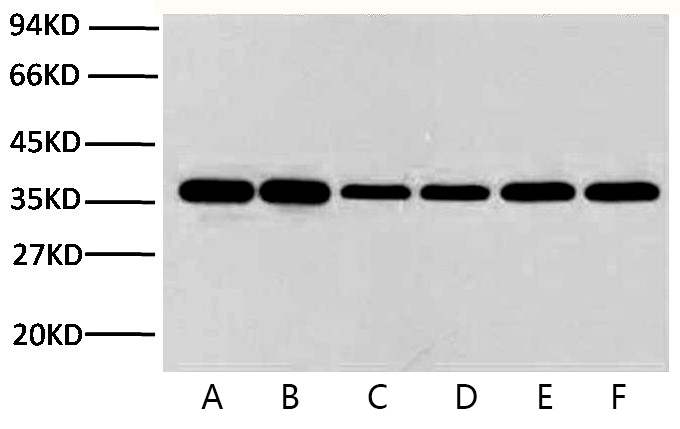
Fig.1. Western blot analysis of Hela (1), rat brain (2), rabbit muscle(3), sheep muscle(4), and mouse brain (5), diluted at 1:10000.
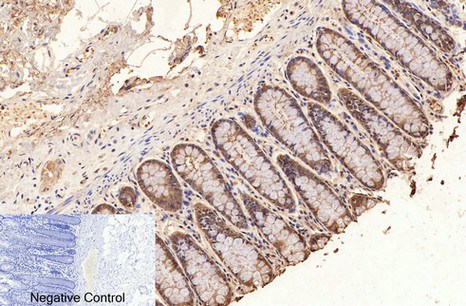
Fig.2. Immunohistochemical analysis of paraffin-embedded human colon tissue. 1, GAPDH Monoclonal Antibody (2B5) was diluted at 1:400 (4°C, overnight). Negative control was used by secondary antibody only.
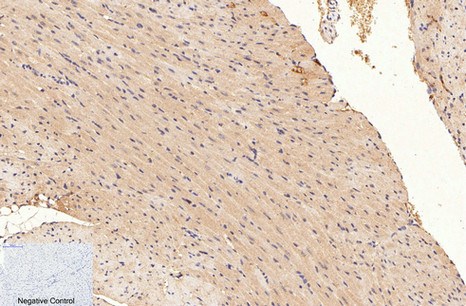
Fig.3. Immunohistochemical analysis of paraffin-embedded mouse heart tissue. 1, GAPDH Monoclonal Antibody (2B5) was diluted at 1:400 (4°C, overnight). Negative control was used by secondary antibody only.
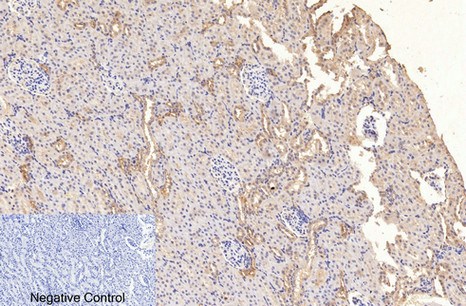
Fig.4. Immunohistochemical analysis of paraffin-embedded rat kidney tissue. 1, GAPDH Monoclonal Antibody (2B5) was diluted at 1:400 (4°C, overnight). Negative control was used by secondary antibody only.
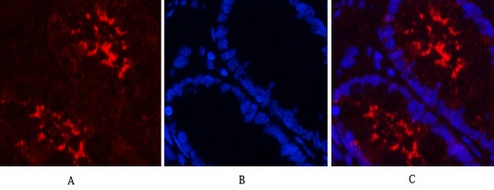
Fig.5. Immunofluorescence analysis of human colon tissue. 1, GAPDH Monoclonal Antibody (2B5) (red) was diluted at 1:400 (4°C, overnight). Picture A: Target. Picture B: DAPI. Picture C: merge of A+B.
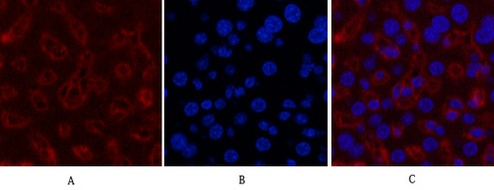
Fig.6. Immunofluorescence analysis of mouse liver tissue. 1, GAPDH Monoclonal Antibody (2B5) (red) was diluted at 1:400 (4°C, overnight). Picture A: Target. Picture B: DAPI. Picture C: merge of A+B.
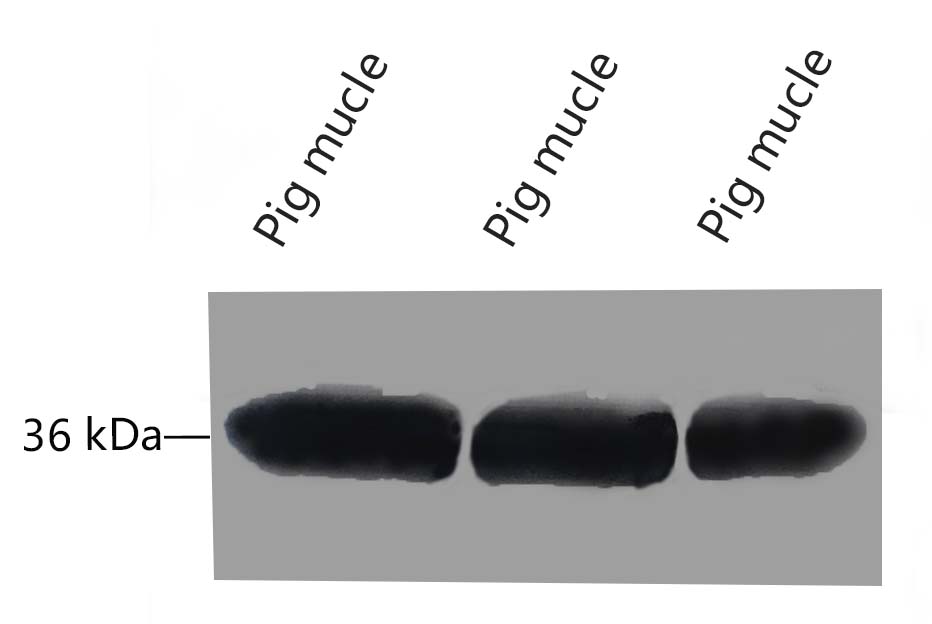
Fig.7 Western blot analysis of Pig muscle tissue, GAPDH Monoclonal Antibody (2B5) was diluted at 1:10000 (25°C, 3h).
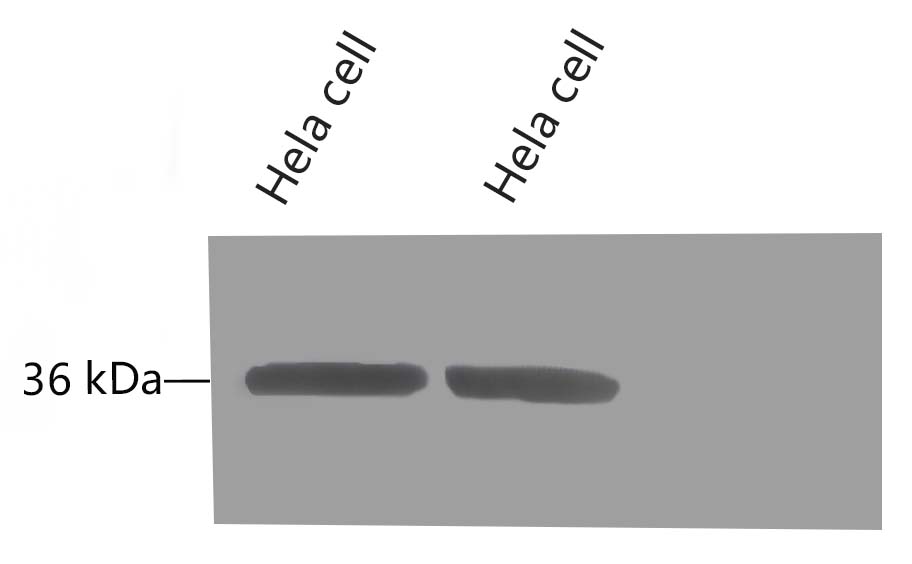
Fig.8 Western blot analysis of Hela, GAPDH Monoclonal Antibody (2B5) was diluted at 1:10000 (25°C, 3h).
Author:D Guo, Y Peng, L Wang, X Sun, X Wang, C Liang Publication name:Molecular Psychiatry, 2019. IF:9.56
Author:Qian Yang, Yuxi Wang, Guangchang Pei, et al Publication name:Cell Death Dis. 2019 Mar 29;10(4):291. IF:5.72
Author:Erhui Jiang, Zhi Xu, Meng Wang, et al Publication name:FASEB J. 2019 Apr;33(4):5690-5703. IF:5.595
Author:X Chen, Z Li, B Zhang, R Hu, J Li, M Feng, W Yao Publication name:The Journal of pain, 2019. IF:5.424
Author:Xuhui Chen, Zuofan Li, BoZhang, et al Publication name:J Pain. 2019 May;20(5):577-591. IF:5.15
Author:Sui, Xiaolu, et al. Publication name:Mediators of Inflammation IF:4.6
Author:Zhang L, Song J, Bai T, et al Publication name:Sci Rep, 2017, 10; 7(1): 4950. IF:4.29
Author:Lu H, Mei C, Yang L, Zheng J, Tong J, Duan F, Liang H, Hong L, Publication name:Front Pharmacol IF:4.225
Author:Meng Wang, Huzi Xu, Octavia Li‑Sien Chong Lee Shin, et al Publication name:J Transl Med. 2019 Apr 11;17(1):122. IF:4.1
Author:Zhenxian Lin, Xiaona Zhang, Fei Zhao and Shaoguo Ru Publication name:Toxicol Appl Pharmacol. 2019 Mar 1;366:75-82. IF:3.88
Author:Zhu F, Chong Lee Shin OLS, Pei G, et al Publication name:Oncotarget, 2017, 8(41): 70707-70726. IF:3.86
Author:Yangfeng Chen, Zhijun Wang Publication name:Genes (Basel) IF:3.759
Author:Juan Han, Runming Jin, et al Publication name:Journal of Leukocyte Biology. 2017; 101(3): 675-681. IF:3.69
Author:Yuan-Feng Zeng, Yi-Sheng Xiao, et al Publication name:World Journal of Gastroenterology. 2018; 24(34): 3884-3897. IF:3.43
Author:Chunwei Cheng, Jun Tan, et al Publication name:Life Sciences. 2018; 209: 157-166. IF:3.40
Author:R He, Y Li, C Han, R Lin, W Qian, X Hou Publication name:International Immunopharmacology, 2019. IF:3.32
Author:Fengming Zhu, Ying Yao, et al Publication name:American Journal of Translational Research. 2017; 9(4): 1694-1707. IF:3.30
Author:Han Zhu, Meng Wang, et al Publication name:American Journal of Translational Research. 2018 ; 10(6): 1762-1772. IF:3.30
Author:S Song, J An, Y Li, S Liu - Molecular immunology, 2019 Publication name: IF:3.28
Author:Zhang L, Song J, Bai T, et al Publication name:European journal of pharmacology, 2016, 780: 180-187. IF:3.24
Author:Liang Y, Yi L, Liu P, et al Publication name:Journal of Cancer. 2018; 9(19): 3603-3612. IF:3.09
Author:Liu Y, Feng X, Zhang Y, et al Publication name:Journal of Orthopaedic Research, 2016. IF:3.07
Author:Zeng T, Zhou J, He L, et al Publication name:PloS one, 2016, 11(3): e0149677. IF:3.02
Author:Hu, Zhizhi, et al. Publication name:Renal Failure IF:3
Author:Yan‑Zi Zhang, Xiao‑Lu Sui, Yun‑Peng Xu, et al Publication name:Int J Mol Med. 2019 Jul;44(1):172-184. IF:2.91
Author:Yuan Liu, Aiping Cao, et al Publication name:BMC Infectious Diseases. 2017; 17(1): 403. IF:2.79
Author:Wang, Chao, et al Publication name:DNA and cell biology 34.12 (2015): 728-735. IF:2.78
Author:Yu Jin, Xiaoyang Ren, et al Publication name:Journal of Gastroenterology and Hepatology. 2018; 33(2): 443-452. IF:2.71
Author:Zhang, Ke, et al. Publication name:Biochemistry and Biophysics Reports IF:2.7
Author:Liu W, Wang H, Wang Y, et al Publication name:Psychiatry research, 2015, 228(3): 257-264. IF:2.56
Author:Wang J H, Zheng W W, Cheng S T, et al Publication name:Molecular medicine reports, 2015, 11(6): 4220-4224. IF:2.39
Author:Zeng Y F, Xiao Y S, Lu M Z, et al Publication name:Experimental and molecular pathology, 2015, 98(2): 260-267. IF:2.39
Author:Wang J H, Zhou W W, Cheng S T, et al Publication name:Molecular medicine reports, 2015, 12(2): 1810-1816. IF:2.39
Author:Zheng X X, Li X Y, Lyu Y N, et al Publication name:Experimental physiology, 2016, 101(2): 260-271. IF:2.38
Author:Zheng X, Li X, Lyu Y, et al Publication name:Medical Science Monitor: International Medical Journal of Experimental and Clinical Research, 2016, 22: 2751. IF:2.03
Author:Zeng T, Liu F, Zhou J, et al Publication name:Endocrine journal, 2015 (0). IF:2.02
Author:L Liang, X Wang, Y Zheng Publication name:Molecular medicine Reports, 2019. IF:1.97
Author:Liu H, Liu Y, Li Y, et al Publication name:Exp Ther Med, 2018, 15(3): 2525-2532. IF:1.50
Author:Sen Yang, Ju He, et al Publication name:Experimental and Therapeutic Medicine. 2018; 16(5): 4042-4048. IF:1.50
Author:X Tan, R Liu, D Zhao, Z He, W Li, M Zheng Publication name:Journal of advanced research IF:1.4
Author:Wang S, Song Y, Wang Y, et al Publication name:Chemical Research in Chinese Universities, 2018, 34(1): 67–74. IF:0.97
Author:Y Liu, M Guo, Y Li, T Wang, Y Ren, R Wang, X Jiang Publication name:researchsquare IF:/
Author:VK Verma, S Malik, AK Sahu, V Prajapati, J Bhatia Publication name:researchsquare IF:0
You must be logged in to post a review.
Reviews
There are no reviews yet.